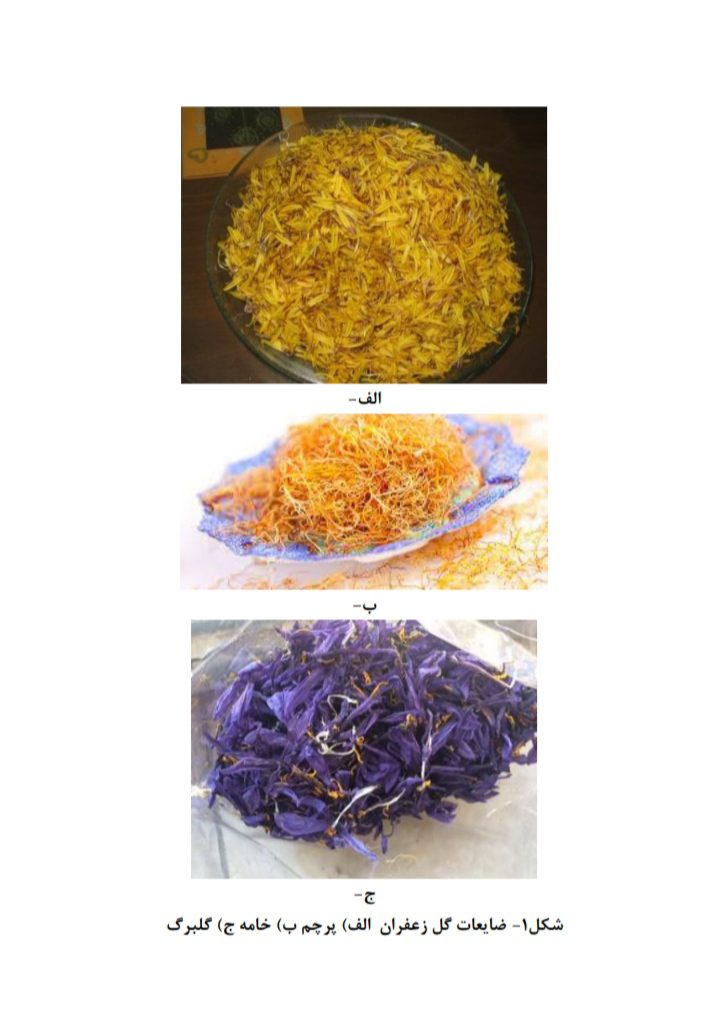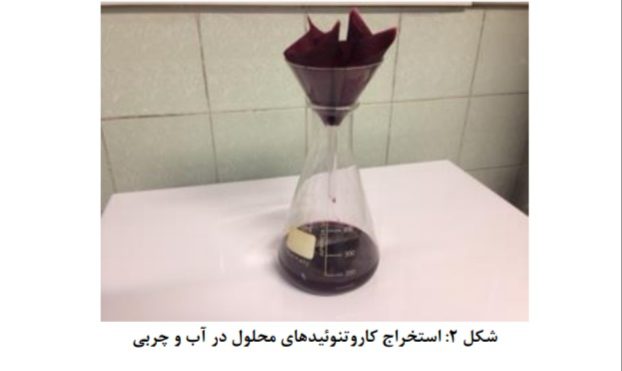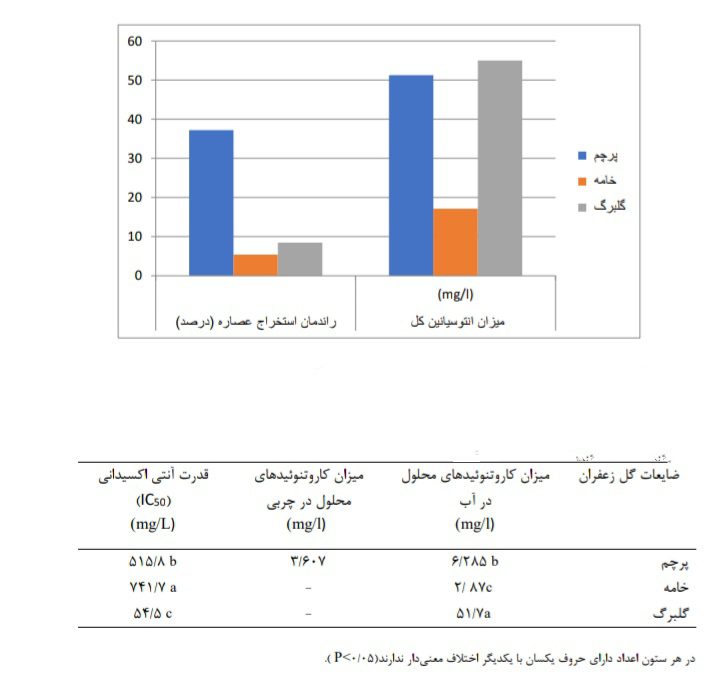

Natural antioxidant combinations extracted from
saffron’s wastage.
Introduction:
Considering Iran’s vast production of saffron, right
now more than 8/88 percent of global saffron
production belongs to Iran and Iran is also
considered world’s biggest saffron producer and exporter.
Weight percentage of fresh flower’s formation
components, 42/84 percent petal and sepal, 935/5 percent stamen, 645/7 percent stigma and style which during the detachment of the stigma from flower, where the stigma is separated from the rest of components, is dried and then it’s sent off to inland and oversea markets but the rest of saffron
like sepal, petal, style and stamen are the side product of saffron’s production which are resulted in around 131000-ton petal and sepal and around 9800-ton stamen. Even though these components include
high amount of valuable subjects but right now they are useless and they are only used to fed the livestock or are deserted in Nature.
If we could use this wastage to create side product with added value such as different types of natural eatable colors or preservative combinations not only we can prevent nature’s pollution but also the
produced subjects have higher added value.
One of qualitative characteristics of eatable
products are their color which nowadays plays an important role in the acceptance of products by costumers. If the product does not have proper coloring that product faces a huge decrease in demands. Other qualitative characteristics like scent, flavor, structure, and other matters are the
parameters evaluated after one purchase and consumption.
Considering the vast utilization of colors in food industry and the reports on how harmful and dangerous these chemical colors are, the extraction and purifying color essence of natural cheap sources is noticed. Along the purpose of this article, methods
of producing natural colors and combinations with antioxidant characteristic from saffron’s wastage are discussed.
1- Preparing components of saffron flower
At first we prepare proper amount of saffron’s wastage (the remaining of saffron after detachment of stigma or technically foliating) and separate different parts like stamen, style and petal (figure 1) and then dry them separately in oven with the temperature of 500C. The dried wastage of saffron flower A) stamen B) style C) petal (figure 1) should turn into powder using
grinder and then it will be packed in plastic bags to prevent them from humidity and are put in a dark cold place.

2- Extracting color essence from flowers’
components
Wastage of saffron flower have pigments that are insoluble and soluble in lipid so with the help of right solvent we can detach these two pigments.
Extracting anthocyanin from anthocyanin
combinations that exist in petal, style and stamen of saffron flower is done by the help of Ethanol (acidic) solvent. The ratio of powdered sample and solvent is 1 to 50. The acidic ethanol solvent is created from combining ethanol 70 and hydrochloride acid 1/5 normal by the ratio of 85 to 15cc. The mixture was blended for 15 minutes by
magnetic stirrer in room temperature, then was filtered by Whatman’s number 1 fitter paper and vacuum pump.
The precipitate was extracted under the same situation. By putting the essence in the temperature of 50 to 550C the solvent was
removed, also for removing solvent while limiting the harm to effective ingredients Rotary evaporator was used in under vacuum temperature of 400C. when the essence is completely dried it will be maintained in dark jars in the refrigerator.
For extracting carotenoids soluble in lipid, non�polar solvents are used. For extracting color from the combination of 3 solvent N-Hexane, petroleum ether or the combination of N-Hexane solvents, acetone, ethanol is used by the ratio of 1:1:2 ratios1:10 sample to solvent.
The extraction lasted two hours in the room
temperature while blending in the dark. Samples were filtered by Whatman’s number 1 filter paper, then 20 percent of used solvent’s volume.
Deionized distilled water were added and samples were divided into organic and aqueous phases. The upper phase was the non-polar phase with the carotenoids soluble in lipid and the down phase was
the aqueous phase of carotenoids soluble in water. soluble carotenoids were removed by airstream orRotary evaporator under vacuum in the temperature of 400C and the remaining essence was put in a dark jar in a dry and cold place.

3- Extracting natural antioxidants:
For extracting natural antioxidants, the method of extraction with soluble is used. To achieve this the sample is stirred for 48 hours with 80 percent ethanol with the ratio of four times the weight of sample. After the first 24 hours the mixture is filtered and after adding ethanol the stirring goes on for another 24 hours. Filtrates are mixed together and the solvent is removed by rotary evaporator and oven under vacuum and the remaining essence is maintained in a dark jar in a dry and cold place.
1- Calculating extraction yield:
Extraction efficiency of saffron comes from
dividing the weight of dried stigma over the initial weight of wet stigmas multiplied by 100.
From dividing the weight of dried essence over the initial weight of subjects we can get the totalamount of dried extracted essence in percentage.
2- Calculating the total amount of anthocyanin combinations:
Calculating anthocyanin has been done by the method of Differential pH according to Gist and Raulstad approach. For this, 2 Buffer with 1 HP (kcl-HCL) and 5/4 (Sodium acetate) were used.
Samples reached the volume with buffers and in two 520 and 700 nanometers wavelengths absorption rate, once with buffer 1 and another time with buffer 2.
3- Calculating the total amount of carotenoids combinations:
First dried samples were diluted with the ratio of 1 to 20, then their absorption spectra in the wavelength of 350 to 500 nanometers were picked by the spectrophotometer and in the maximum absorption wavelength, the absorbed amount of each sample was read.
Conclusion:
Figure 1 shows the extraction efficiency and the total amount of anthocyanin in the wastage of saffron.

Chart 1 shows the amount of color combinations and antioxidants that exist in saffron’s wastage.
Chart 1:extraction efficiency, the amount of color combinations and antioxidants that exist in saffron’s wastage Figure 1 and chart 1 has shown that the extraction
efficiency of essence from the wastage of saffron flower is around 37 to 48 percent of the dry subject (chart 1) and among wastages of saffron, petal with 8/48 percent has the highest amount of extraction efficiency.
Chart 1 shows that exiting anthocyanin in the wastage of saffron flower are around 17/15 to 5/998 milligram in each liter, its highest amount is in petal (5/998 milligram in liter) and the lowest amount is in style (17/15 milligram in liter). In the territory of plants anthocyanin are the biggest group of soluble pigments in water and they belong
to a family of molecules by the name of Flavonoids.
The best sources for anthocyanin are the family of berries such as: blueberry, cranberry, blackberry, raspberry and other vegetables such as: Muscat grapes, red cabbage, black rice, eggplant. They are
in charge of the process of coloring in many
flowers, fruits and berries and can be used as natural colors in food industry. The anthocyanin in these subjects are around 50 milligrams in 1200 liter. The amount of this subject in saffron’s petal is competitive with other mentioned sources therefore, the petal of saffron is considered a cheap and rich source of this subject.
Wastage of saffron has high amount of different kinds of carotenoids soluble in water and carotenoids soluble in lipid (chart 1). Carotenoids are a group of pigments in the range of yellow, orange and red which play an important role in the absorption of sunlight in plants. Here are some
well-known carotenoids: beta-carotene, alpha�carotene, Lycopene, lutein and Xanthophyll which are mainly soluble in lipid, Crocin (saffron’s pigment) is the only carotenoid soluble in water and as you can see in chart 1, the wastage of saffron
contains this pigment. Among these wastages of saffron, petal with 7/51 milligrams on liter has the highest amount of carotenoids soluble in water and after that stamen of saffron has more of this subject compared to the style of saffron
(chart 1).
But between these wastages of saffron the style of saffron with 6/3 milligram on liter has the highest amount of carotenoids soluble in lipid.
Chart 1 suggests that saffron’s petal has the
lowest IC50 and this indicates that the power of its antioxidant is higher, the lower the amount of IC50, the higher the effect of its antioxidant and that’s because the oxidation inhibition power is done with less concentration. Since the amount of
anthocyanin is high in saffron’s petal therefore the high amount of its antioxidants are justified because there is a straight connection between the amount of anthocyanin and the power of antioxidants (Riceevand et al, 1996. Malthrem et al,
2013).
L
Since the wastage of saffron has high amounts of combinations such as anthocyanin, carotenoids and
Phenyl, it caused them to contain natural color components and combinations that have powerful antioxidant strength, it can be used in food and pharmaceutical industries as natural coloring components or natural antioxidant sources.
Considering the rich vegetation of Iran’s north east region and with keeping in mind the undesirable effects of synthetic antioxidant and synthetic colors, while keeping an eye on pollen’s
medicinal and nutritional properties we can prepare the floor for its usage in food and pharmaceutical industries as a new source of color and antioxidant.



